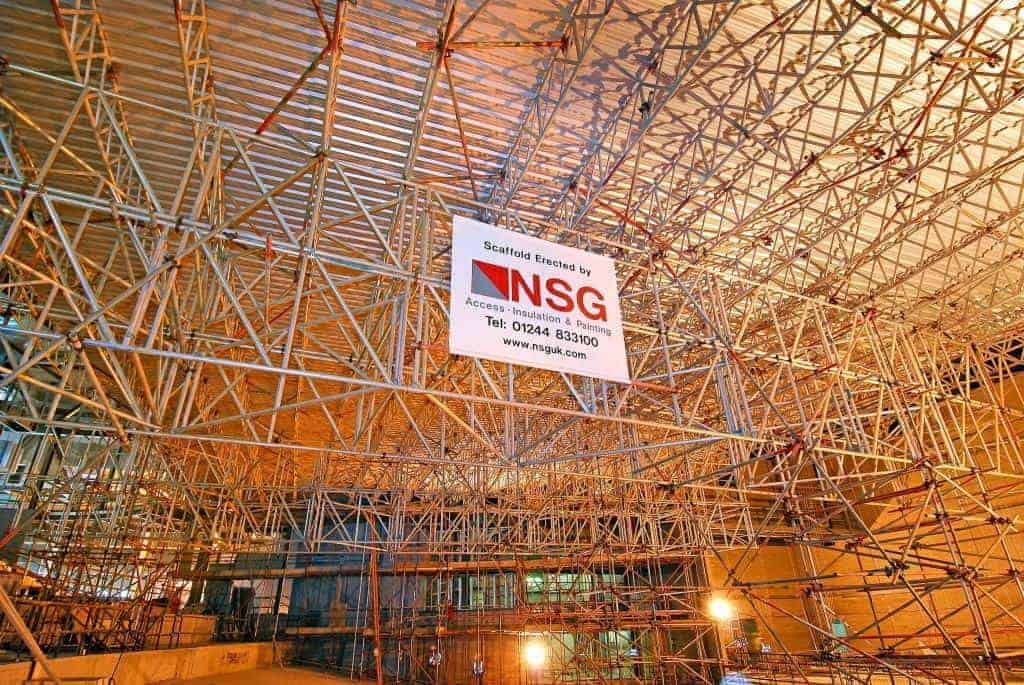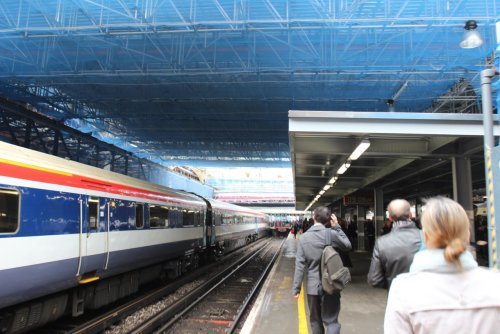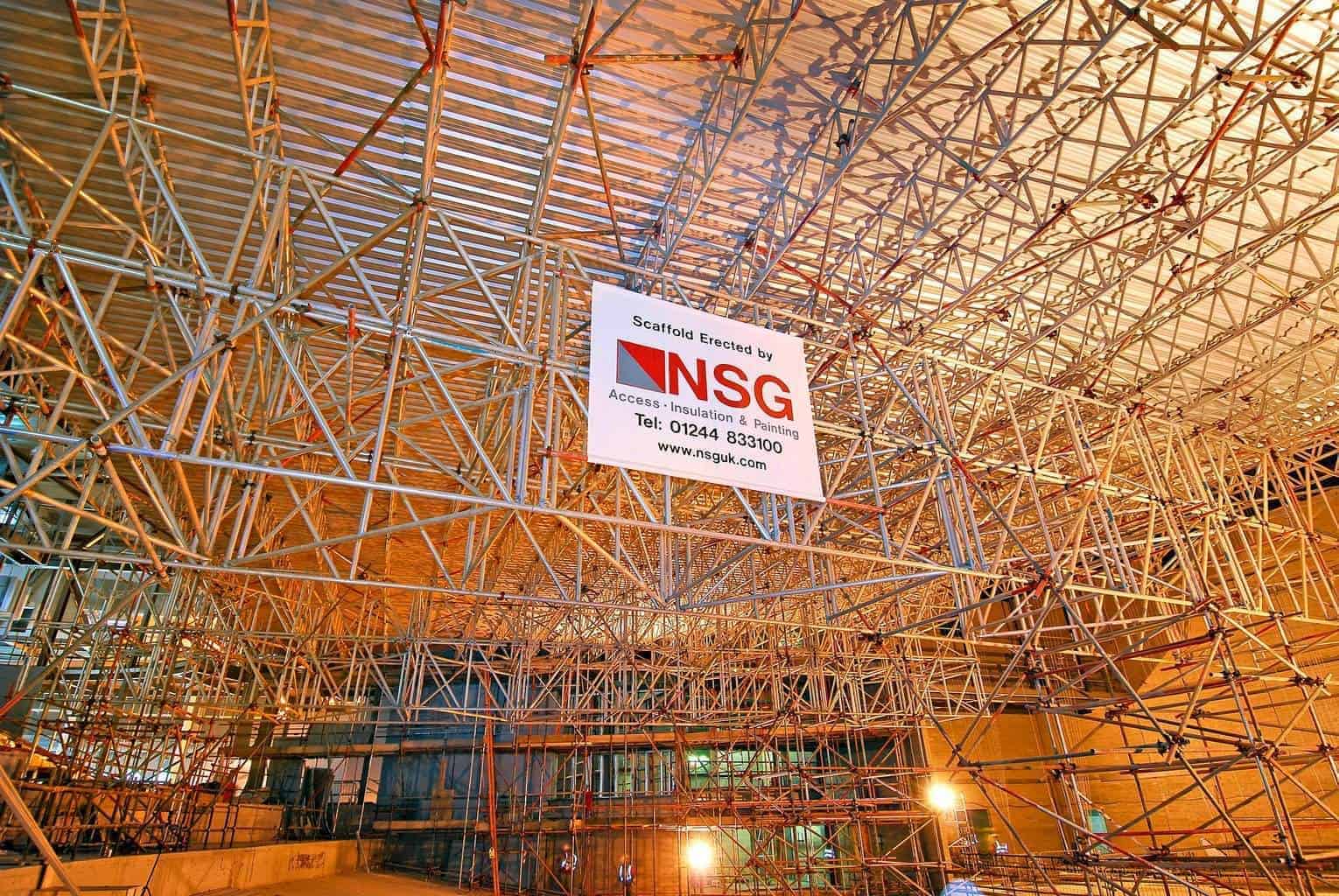 Scaffolding and industrial services firm Altrad NSG has achieved its eighth consecutive Gold Standard for excellence in health and safety.
The Deeside based firm, which operates at sites across the UK, was awarded a Gold Medal for Occupational Health & Safety, by the Royal Society for the Prevention of Accidents (RoSPA).
The award was presented by RoSPA to recognise the company’s achievement and commitment to raising the standards of health and safety management at its Ineos Chlor site in Runcorn. Altrad NSG is now setting its sights on two more years of continuous health and safety success to achieve a RoSPA President’s Award – presented to organisations who achieve 10 or more years of consecutive Gold standard.
Paul Hemingway, Health and Safety Advisor at Altrad NSG, said: “Safety is paramount to the business so we are delighted to be recognised with our eighth consecutive RoSPA Gold Award. Alongside our British Safety Council Five Star Award and Sword of Honour, it demonstrates to our clients and potential customers that we are a responsible and conscientious business that places health and safety as top priority.
“We have 140 staff at our Ineos Chlor site, providing multi-discipline maintenance works including scaffolding, rope access, painting and industrial cleaning, as well as thermal insulation and sheet metal work, together with road gritting, rigging and slinging and high pressure water jetting. We had to provide RoSPA with strong evidence of best practice health and safety management, highlighting our excellent track record over the past year. This continuing success has only been achievable because of the commitment to health and safety from all site operatives and the Site Management Team.”
David Dawlins, RoSPA Award Manager, said: “RoSPA firmly believes that organisations that demonstrate commitment to continuous improvement in accident and ill health prevention deserve recognition. Altrad NSG Limited – Ineos Site Runcorn has shown that it is committed to striving for such continuous improvement and we are delighted to honour it through the presentation of an award.”
Ineos Chlor is a leading global manufacturer of chlorine and PVC – its Runcorn site is the company’s biggest in the UK.
Will Gretton, Altrad NSG Health and Safety Manager, added: “We have also had our Asbestos Ancillary Licence for scaffolding renewed until 2016 – few other scaffolders hold this license and we have had to undergo rigorous assessment by the HSE. This means we are able to continue to provide access to asbestos removal sites and is another endorsement of our quality and robust health and safety procedures.
“We are continuing to invest in training across the workforce and have just completed Asbestos Awareness, Risk Assessment and Manual Handling training courses for the whole of the Altrad NSG workforce.”
Altrad NSG works with a range of blue chip construction clients, providing scaffolding and rope access systems, insulation, painting, coatings, blasting and industrial cleaning. Core sectors include on and offshore oil and gas, petrochemical, pharmaceutical, power generation (including nuclear), steel production, shipbuilding, rail and civil infrastructure.
In 2011 the business was purchased by French based multinational Altrad SA.
Scaffolding and industrial services firm Altrad NSG has achieved its eighth consecutive Gold Standard for excellence in health and safety.
The Deeside based firm, which operates at sites across the UK, was awarded a Gold Medal for Occupational Health & Safety, by the Royal Society for the Prevention of Accidents (RoSPA).
The award was presented by RoSPA to recognise the company’s achievement and commitment to raising the standards of health and safety management at its Ineos Chlor site in Runcorn. Altrad NSG is now setting its sights on two more years of continuous health and safety success to achieve a RoSPA President’s Award – presented to organisations who achieve 10 or more years of consecutive Gold standard.
Paul Hemingway, Health and Safety Advisor at Altrad NSG, said: “Safety is paramount to the business so we are delighted to be recognised with our eighth consecutive RoSPA Gold Award. Alongside our British Safety Council Five Star Award and Sword of Honour, it demonstrates to our clients and potential customers that we are a responsible and conscientious business that places health and safety as top priority.
“We have 140 staff at our Ineos Chlor site, providing multi-discipline maintenance works including scaffolding, rope access, painting and industrial cleaning, as well as thermal insulation and sheet metal work, together with road gritting, rigging and slinging and high pressure water jetting. We had to provide RoSPA with strong evidence of best practice health and safety management, highlighting our excellent track record over the past year. This continuing success has only been achievable because of the commitment to health and safety from all site operatives and the Site Management Team.”
David Dawlins, RoSPA Award Manager, said: “RoSPA firmly believes that organisations that demonstrate commitment to continuous improvement in accident and ill health prevention deserve recognition. Altrad NSG Limited – Ineos Site Runcorn has shown that it is committed to striving for such continuous improvement and we are delighted to honour it through the presentation of an award.”
Ineos Chlor is a leading global manufacturer of chlorine and PVC – its Runcorn site is the company’s biggest in the UK.
Will Gretton, Altrad NSG Health and Safety Manager, added: “We have also had our Asbestos Ancillary Licence for scaffolding renewed until 2016 – few other scaffolders hold this license and we have had to undergo rigorous assessment by the HSE. This means we are able to continue to provide access to asbestos removal sites and is another endorsement of our quality and robust health and safety procedures.
“We are continuing to invest in training across the workforce and have just completed Asbestos Awareness, Risk Assessment and Manual Handling training courses for the whole of the Altrad NSG workforce.”
Altrad NSG works with a range of blue chip construction clients, providing scaffolding and rope access systems, insulation, painting, coatings, blasting and industrial cleaning. Core sectors include on and offshore oil and gas, petrochemical, pharmaceutical, power generation (including nuclear), steel production, shipbuilding, rail and civil infrastructure.
In 2011 the business was purchased by French based multinational Altrad SA.
Altrad NSG Gains Gold Medal For Safety Excellence
 Scaffolding and industrial services firm Altrad NSG has achieved its eighth consecutive Gold Standard for excellence in health and safety.
The Deeside based firm, which operates at sites across the UK, was awarded a Gold Medal for Occupational Health & Safety, by the Royal Society for the Prevention of Accidents (RoSPA).
The award was presented by RoSPA to recognise the company’s achievement and commitment to raising the standards of health and safety management at its Ineos Chlor site in Runcorn. Altrad NSG is now setting its sights on two more years of continuous health and safety success to achieve a RoSPA President’s Award – presented to organisations who achieve 10 or more years of consecutive Gold standard.
Paul Hemingway, Health and Safety Advisor at Altrad NSG, said: “Safety is paramount to the business so we are delighted to be recognised with our eighth consecutive RoSPA Gold Award. Alongside our British Safety Council Five Star Award and Sword of Honour, it demonstrates to our clients and potential customers that we are a responsible and conscientious business that places health and safety as top priority.
“We have 140 staff at our Ineos Chlor site, providing multi-discipline maintenance works including scaffolding, rope access, painting and industrial cleaning, as well as thermal insulation and sheet metal work, together with road gritting, rigging and slinging and high pressure water jetting. We had to provide RoSPA with strong evidence of best practice health and safety management, highlighting our excellent track record over the past year. This continuing success has only been achievable because of the commitment to health and safety from all site operatives and the Site Management Team.”
David Dawlins, RoSPA Award Manager, said: “RoSPA firmly believes that organisations that demonstrate commitment to continuous improvement in accident and ill health prevention deserve recognition. Altrad NSG Limited – Ineos Site Runcorn has shown that it is committed to striving for such continuous improvement and we are delighted to honour it through the presentation of an award.”
Ineos Chlor is a leading global manufacturer of chlorine and PVC – its Runcorn site is the company’s biggest in the UK.
Will Gretton, Altrad NSG Health and Safety Manager, added: “We have also had our Asbestos Ancillary Licence for scaffolding renewed until 2016 – few other scaffolders hold this license and we have had to undergo rigorous assessment by the HSE. This means we are able to continue to provide access to asbestos removal sites and is another endorsement of our quality and robust health and safety procedures.
“We are continuing to invest in training across the workforce and have just completed Asbestos Awareness, Risk Assessment and Manual Handling training courses for the whole of the Altrad NSG workforce.”
Altrad NSG works with a range of blue chip construction clients, providing scaffolding and rope access systems, insulation, painting, coatings, blasting and industrial cleaning. Core sectors include on and offshore oil and gas, petrochemical, pharmaceutical, power generation (including nuclear), steel production, shipbuilding, rail and civil infrastructure.
In 2011 the business was purchased by French based multinational Altrad SA.
Scaffolding and industrial services firm Altrad NSG has achieved its eighth consecutive Gold Standard for excellence in health and safety.
The Deeside based firm, which operates at sites across the UK, was awarded a Gold Medal for Occupational Health & Safety, by the Royal Society for the Prevention of Accidents (RoSPA).
The award was presented by RoSPA to recognise the company’s achievement and commitment to raising the standards of health and safety management at its Ineos Chlor site in Runcorn. Altrad NSG is now setting its sights on two more years of continuous health and safety success to achieve a RoSPA President’s Award – presented to organisations who achieve 10 or more years of consecutive Gold standard.
Paul Hemingway, Health and Safety Advisor at Altrad NSG, said: “Safety is paramount to the business so we are delighted to be recognised with our eighth consecutive RoSPA Gold Award. Alongside our British Safety Council Five Star Award and Sword of Honour, it demonstrates to our clients and potential customers that we are a responsible and conscientious business that places health and safety as top priority.
“We have 140 staff at our Ineos Chlor site, providing multi-discipline maintenance works including scaffolding, rope access, painting and industrial cleaning, as well as thermal insulation and sheet metal work, together with road gritting, rigging and slinging and high pressure water jetting. We had to provide RoSPA with strong evidence of best practice health and safety management, highlighting our excellent track record over the past year. This continuing success has only been achievable because of the commitment to health and safety from all site operatives and the Site Management Team.”
David Dawlins, RoSPA Award Manager, said: “RoSPA firmly believes that organisations that demonstrate commitment to continuous improvement in accident and ill health prevention deserve recognition. Altrad NSG Limited – Ineos Site Runcorn has shown that it is committed to striving for such continuous improvement and we are delighted to honour it through the presentation of an award.”
Ineos Chlor is a leading global manufacturer of chlorine and PVC – its Runcorn site is the company’s biggest in the UK.
Will Gretton, Altrad NSG Health and Safety Manager, added: “We have also had our Asbestos Ancillary Licence for scaffolding renewed until 2016 – few other scaffolders hold this license and we have had to undergo rigorous assessment by the HSE. This means we are able to continue to provide access to asbestos removal sites and is another endorsement of our quality and robust health and safety procedures.
“We are continuing to invest in training across the workforce and have just completed Asbestos Awareness, Risk Assessment and Manual Handling training courses for the whole of the Altrad NSG workforce.”
Altrad NSG works with a range of blue chip construction clients, providing scaffolding and rope access systems, insulation, painting, coatings, blasting and industrial cleaning. Core sectors include on and offshore oil and gas, petrochemical, pharmaceutical, power generation (including nuclear), steel production, shipbuilding, rail and civil infrastructure.
In 2011 the business was purchased by French based multinational Altrad SA.
Cape announces collaborative supply agreement with HAKI
 Official confirmation has been announced today that Cape will be supplying and installing the HAKI system scaffolding over other systems.
It’s official.. Cape plc have today confirmed with a press release that the firm will be using HAKI system scaffolding over other competing system products.
Cape Plc today released this statement:
Cape plc, the international provider of essential support services to the energy and mineral resources sectors, is pleased to announce that it has entered into a collaborative supply agreement with the system scaffolding specialist HAKI.
Cape erects or dismantles over 2,000 individual scaffolds a day. Any efficiency that can be introduced to that process will ultimately improve the service clients receive. In early 2013 Cape carried out a robust review of various scaffolding systems in the UK market. ‘’Our scaffolding teams work in a huge variety of different locations, each with their own particular technical challenges.’’ explains Simon Hicks, Capes UK Head of Strategic Development. ‘’Finding an intelligent solution that could improve our performance in a safe and reliable way was key.’’
After a thorough review, the HAKI® Universal System was selected to be the best solutions that meet the needs and requirements of Cape and its clients. The HAKI system benefits from many unique features such as fewer contact points and larger bay sizes which help increase productivity. As Simon explains, ‘’we chose HAKI because of the excellent safety features of the system. It’s a high-quality, Swedish-engineered product, and we get great technical support from HAKI’s UK-based team. Deployed in the right place, we believe that the HAKI system is more efficient and delivers greater productivity gains than other systems on the market, and our people really like using it.’’
HAKI’s Vice President of Marketing and Business Development, Chris Stokes commented:
‘’HAKI is proud to be chosen as Cape’s principle supplier of system scaffold, after a demanding selection process this is a great endorsement. This investment reinforces Cape’s powerful scaffolding and access service offering and demonstrates the effectiveness of HAKI for demanding industrial applications.’’
Case Study
Cape has already started to implement the HAKI system, with the south sphere on the Polimeri Europa site in Hythe, being one of the notable successes. Access was required to the sphere structure to remove its fireproof coating and to carry out radiography testing. The Cape team built a large internal scaffold using collective measures and meeting requirements of SG4:10. Feedback from the client was positive, who told cape they were impressed with the ‘’monstrous but beautiful scaffold’’.
Press release source: http://www.capeplc.com/news-and-media/news-announcements/2013/6/cape-enters-collaborative-supply-agreement-with-haki.aspx
Official confirmation has been announced today that Cape will be supplying and installing the HAKI system scaffolding over other systems.
It’s official.. Cape plc have today confirmed with a press release that the firm will be using HAKI system scaffolding over other competing system products.
Cape Plc today released this statement:
Cape plc, the international provider of essential support services to the energy and mineral resources sectors, is pleased to announce that it has entered into a collaborative supply agreement with the system scaffolding specialist HAKI.
Cape erects or dismantles over 2,000 individual scaffolds a day. Any efficiency that can be introduced to that process will ultimately improve the service clients receive. In early 2013 Cape carried out a robust review of various scaffolding systems in the UK market. ‘’Our scaffolding teams work in a huge variety of different locations, each with their own particular technical challenges.’’ explains Simon Hicks, Capes UK Head of Strategic Development. ‘’Finding an intelligent solution that could improve our performance in a safe and reliable way was key.’’
After a thorough review, the HAKI® Universal System was selected to be the best solutions that meet the needs and requirements of Cape and its clients. The HAKI system benefits from many unique features such as fewer contact points and larger bay sizes which help increase productivity. As Simon explains, ‘’we chose HAKI because of the excellent safety features of the system. It’s a high-quality, Swedish-engineered product, and we get great technical support from HAKI’s UK-based team. Deployed in the right place, we believe that the HAKI system is more efficient and delivers greater productivity gains than other systems on the market, and our people really like using it.’’
HAKI’s Vice President of Marketing and Business Development, Chris Stokes commented:
‘’HAKI is proud to be chosen as Cape’s principle supplier of system scaffold, after a demanding selection process this is a great endorsement. This investment reinforces Cape’s powerful scaffolding and access service offering and demonstrates the effectiveness of HAKI for demanding industrial applications.’’
Case Study
Cape has already started to implement the HAKI system, with the south sphere on the Polimeri Europa site in Hythe, being one of the notable successes. Access was required to the sphere structure to remove its fireproof coating and to carry out radiography testing. The Cape team built a large internal scaffold using collective measures and meeting requirements of SG4:10. Feedback from the client was positive, who told cape they were impressed with the ‘’monstrous but beautiful scaffold’’.
Press release source: http://www.capeplc.com/news-and-media/news-announcements/2013/6/cape-enters-collaborative-supply-agreement-with-haki.aspx
Harsco opens new scaffolding training center in Immingham
Turner Access announce the retirement of its Managing Director

Scaffolder’s lack of safety measures put lives at risk
 A scaffolder has been prosecuted for neglecting vital safety measures that put himself, his staff and passing members of the public at risk.
Truro Magistrates’ Court heard on Friday (24 May) that an inspector from the Health and Safety Executive (HSE) saw workers on scaffolding with no edge protection at a property in Cranberry Road, Camborne, in March 2012. They were not wearing any harnesses or lanyards to protect them from falls.
The Inspector issued an immediate Prohibition Notice on Anthony Dale scaffolding, halting any further work at the site until improvements were made.
The court was told that following an investigation into Mr Dale on another matter, Cornwall Council sent pictures to HSE showing him again working on scaffolding without any edge protection or harnesses.
Workers for Anthony Dale and Dale himself were seen twice on scaffolding with no edge protection or safety equipment that could have helped them in the event of a fall at sites in Chapel Street, Penzance, and Coinagehall Street, Helston, in 2012.
Anthony Dale of Roskear Parc, Tuckingmill, Camborne, pleaded guilty to breaching Section 2(2) and Section 3(1) of the Health and Safety at Work etc Act 1974 and was fined a total of £8,000 and ordered to pay £4,114 in costs.
Speaking after the hearing, HSE Inspector Barry Trudgian, said:
“Work at height is the biggest single cause of fatal and serious injury in the construction industry. Anthony Dale’s reckless disregard of basic safety precautions demonstrates a totally a cavalier approach to the health and well-being of his workers and of passers-by, let alone himself.
“The risks of working at height are widely-known and recognised and there is a wealth of guidance available from HSE and the industry. There can really be no excuse for not putting basic precautions in place.
“Simple measures such as providing guardrails and having the correct safety equipment could save someone’s life.”
Further information on safe scaffolding can be found on the HSE website at:http://www.hse.gov.uk/construction/faq-scaffold.htm
A scaffolder has been prosecuted for neglecting vital safety measures that put himself, his staff and passing members of the public at risk.
Truro Magistrates’ Court heard on Friday (24 May) that an inspector from the Health and Safety Executive (HSE) saw workers on scaffolding with no edge protection at a property in Cranberry Road, Camborne, in March 2012. They were not wearing any harnesses or lanyards to protect them from falls.
The Inspector issued an immediate Prohibition Notice on Anthony Dale scaffolding, halting any further work at the site until improvements were made.
The court was told that following an investigation into Mr Dale on another matter, Cornwall Council sent pictures to HSE showing him again working on scaffolding without any edge protection or harnesses.
Workers for Anthony Dale and Dale himself were seen twice on scaffolding with no edge protection or safety equipment that could have helped them in the event of a fall at sites in Chapel Street, Penzance, and Coinagehall Street, Helston, in 2012.
Anthony Dale of Roskear Parc, Tuckingmill, Camborne, pleaded guilty to breaching Section 2(2) and Section 3(1) of the Health and Safety at Work etc Act 1974 and was fined a total of £8,000 and ordered to pay £4,114 in costs.
Speaking after the hearing, HSE Inspector Barry Trudgian, said:
“Work at height is the biggest single cause of fatal and serious injury in the construction industry. Anthony Dale’s reckless disregard of basic safety precautions demonstrates a totally a cavalier approach to the health and well-being of his workers and of passers-by, let alone himself.
“The risks of working at height are widely-known and recognised and there is a wealth of guidance available from HSE and the industry. There can really be no excuse for not putting basic precautions in place.
“Simple measures such as providing guardrails and having the correct safety equipment could save someone’s life.”
Further information on safe scaffolding can be found on the HSE website at:http://www.hse.gov.uk/construction/faq-scaffold.htm Layher introduces Allround Lightweight system scaffolding
 KHL.com has reported that Layher has debuted a new, lighter scaffolding solution – Allround Lightweight. Shown for the first time at Bauma 2013 in Munich, the Allround Lightweight modular scaffolding system features lighter components, increased load-bearing capacity and an AUtoLock function for wedge-head connectors.
According to Layher, Allround Lightweight can be assembled 10 percent faster than competitive scaffold systems and transport is 12 percent more efficient.
“Since assembly, dismantling and transport still account for 80 percent of the costs for scaffolding construction, three factors are critically important: design, functionality and component weight,” said Layher’s marketing director Franz Greisinger. “The focus is on making scaffolding construction easier, safer, and above all more economical. Studies have clearly shown that a significant reduction in assembly and dismantling time can be achieved by cutting back on component weight.”
To get Allround Lightweight as light as possible, Layher used high-tensile steel that allowed the company to make components with thinner walls. The wall thickness of the new ALlround standards LW has been reduced from 3.2mm to 2.8 mm.
“Depending on the length of the components, scaffolding erectors have up to 14 percent less weight to handle when transporting components by truck to the construction site and in scaffolding assembly itself,” the company said. “The wall thickness has been reduced in Allround O-ledgers LW as well, saving up to 1.6 kg while increasing bending stress capacity by 24 percent.”
To make transportation more efficient, Layher lowered the structural height of the product which reduces storage volumes. With the additional reduction in weight, scaffolders have faster loading and unloading time.
“With its 12 percent higher transport efficiency, Allround Lightweight requires fewer trips, which reduces transport costs for medium-size and large projects,” the company said. “In this way it is also friendlier to the environment.”
Also new is the AutoLock function that creates a positive connection between ledger and rosette. To bring the self-locking wedge into position, the fitter gives the ledger a quick turn and tips it forward. Then they place the wedge-head above the rosette of the Allround standard. When the wedge makes contact with the standard, it is automatically activated and falls into the recess provided for it. A hammer blow then creates a force transmitting connection. This saves one operation for each ledger connection and allows ledgers to be fitted from a secure position.
Lastly, the new U-ledgers LW are one-fourth lighter because the high-tensile steel makes V-reinforcement unnecessary, the company said. The structural height of the ledgers has been reduced by 4.5 cm. The new reinforced Allround U-ledgers LW have 10 cm more clearance than the previous U-bridging ledgers without compromising on load-bearing capacity.
Story Via: KHL.com
KHL.com has reported that Layher has debuted a new, lighter scaffolding solution – Allround Lightweight. Shown for the first time at Bauma 2013 in Munich, the Allround Lightweight modular scaffolding system features lighter components, increased load-bearing capacity and an AUtoLock function for wedge-head connectors.
According to Layher, Allround Lightweight can be assembled 10 percent faster than competitive scaffold systems and transport is 12 percent more efficient.
“Since assembly, dismantling and transport still account for 80 percent of the costs for scaffolding construction, three factors are critically important: design, functionality and component weight,” said Layher’s marketing director Franz Greisinger. “The focus is on making scaffolding construction easier, safer, and above all more economical. Studies have clearly shown that a significant reduction in assembly and dismantling time can be achieved by cutting back on component weight.”
To get Allround Lightweight as light as possible, Layher used high-tensile steel that allowed the company to make components with thinner walls. The wall thickness of the new ALlround standards LW has been reduced from 3.2mm to 2.8 mm.
“Depending on the length of the components, scaffolding erectors have up to 14 percent less weight to handle when transporting components by truck to the construction site and in scaffolding assembly itself,” the company said. “The wall thickness has been reduced in Allround O-ledgers LW as well, saving up to 1.6 kg while increasing bending stress capacity by 24 percent.”
To make transportation more efficient, Layher lowered the structural height of the product which reduces storage volumes. With the additional reduction in weight, scaffolders have faster loading and unloading time.
“With its 12 percent higher transport efficiency, Allround Lightweight requires fewer trips, which reduces transport costs for medium-size and large projects,” the company said. “In this way it is also friendlier to the environment.”
Also new is the AutoLock function that creates a positive connection between ledger and rosette. To bring the self-locking wedge into position, the fitter gives the ledger a quick turn and tips it forward. Then they place the wedge-head above the rosette of the Allround standard. When the wedge makes contact with the standard, it is automatically activated and falls into the recess provided for it. A hammer blow then creates a force transmitting connection. This saves one operation for each ledger connection and allows ledgers to be fitted from a secure position.
Lastly, the new U-ledgers LW are one-fourth lighter because the high-tensile steel makes V-reinforcement unnecessary, the company said. The structural height of the ledgers has been reduced by 4.5 cm. The new reinforced Allround U-ledgers LW have 10 cm more clearance than the previous U-bridging ledgers without compromising on load-bearing capacity.
Story Via: KHL.com Major scaffolding collapse could’ve happened in Manchester

Company boss fined after scaffolder fell to his death

Introducing our new Scaffolding Jobs Board
 We have recently added a great new feature on the site.. Introducing our new daily updated Scaffolding Jobs Board.
Job Seekers: Find your perfect Scaffolding Job here, search, view and apply for all types of scaffolding related jobs from around the world.
Employers: Reach thousands of potential employees by posting your own scaffolding jobs for FREE. We also give you the option to choose a premium listing for your job posting increasing your ad exposure for 30 days. With a premium listing your job will be promoted on every page of Scaffmag.com and promoted using our social media channels (Facebook & Twitter)
With this new upgrade we are able to offer job seekers the very latest available scaffolding jobs within the United Kingdom and globally. We can also offer employers the opportunity to themselves post 30 day job advertisements on site FREE of charge. Also available is a premium option for extra exposure to a targeted audience. Please try it out for yourself by visiting our jobs board today.
We have recently added a great new feature on the site.. Introducing our new daily updated Scaffolding Jobs Board.
Job Seekers: Find your perfect Scaffolding Job here, search, view and apply for all types of scaffolding related jobs from around the world.
Employers: Reach thousands of potential employees by posting your own scaffolding jobs for FREE. We also give you the option to choose a premium listing for your job posting increasing your ad exposure for 30 days. With a premium listing your job will be promoted on every page of Scaffmag.com and promoted using our social media channels (Facebook & Twitter)
With this new upgrade we are able to offer job seekers the very latest available scaffolding jobs within the United Kingdom and globally. We can also offer employers the opportunity to themselves post 30 day job advertisements on site FREE of charge. Also available is a premium option for extra exposure to a targeted audience. Please try it out for yourself by visiting our jobs board today. XERVON Palmers London Bridge Station roof project nears completion
 Leading scaffolding contractor, XERVON Palmers, are in the final stages of a 14-month contract worth £20 million to deconstruct the train shed roof at the historic, busy London Bridge Railway Station – opening up the station to the sky for the first time in over 100 years.
[dropcap]C[/dropcap]rucially, the XERVON Palmers contract has been completed without the use of major cranes and with all railway operations continuing as normal, 24-hours a day – with the station still capable of serving its 100,000+ passengers per day, and no disruption to station operations, or traffic surrounding the venue – with XERVON Palmers running a separate day and a night shift of operatives and managers.
The huge project – which included creating a structurally-supportive 18,000 square metre protection deck running the full 70m across the station with some 10,000 aluminium special access panels and 350 tonnes of temporary steel and a secondary mobile access system – is part of a £600 million, five year long (running to 2018) refurbishment programme aiming to successfully redevelop one of London’s most historic and busy stations, in partnership with main contractor Costain and Network Rail.
In addition to the design and construction of the mobile protection deck (rolled into place using modern ‘cassette’ techniques), the sequenced, safe removal of the dilapidated, historic, crescent-shaped train shed roof and the creation of a mobile access walkway in the side roofs to remove the roof cladding (with a bespoke access in the central barrel of the site with integral support beams), XERVON Palmers operatives also managed waste and recycling. More than 1,200 tons of steel has been removed (all by hand) and asbestos has been removed from site along with rare heritage material, in the form of pre-1880, Georgian wrought iron and polished re-enforced glass, which has also been recycled.
Leading scaffolding contractor, XERVON Palmers, are in the final stages of a 14-month contract worth £20 million to deconstruct the train shed roof at the historic, busy London Bridge Railway Station – opening up the station to the sky for the first time in over 100 years.
[dropcap]C[/dropcap]rucially, the XERVON Palmers contract has been completed without the use of major cranes and with all railway operations continuing as normal, 24-hours a day – with the station still capable of serving its 100,000+ passengers per day, and no disruption to station operations, or traffic surrounding the venue – with XERVON Palmers running a separate day and a night shift of operatives and managers.
The huge project – which included creating a structurally-supportive 18,000 square metre protection deck running the full 70m across the station with some 10,000 aluminium special access panels and 350 tonnes of temporary steel and a secondary mobile access system – is part of a £600 million, five year long (running to 2018) refurbishment programme aiming to successfully redevelop one of London’s most historic and busy stations, in partnership with main contractor Costain and Network Rail.
In addition to the design and construction of the mobile protection deck (rolled into place using modern ‘cassette’ techniques), the sequenced, safe removal of the dilapidated, historic, crescent-shaped train shed roof and the creation of a mobile access walkway in the side roofs to remove the roof cladding (with a bespoke access in the central barrel of the site with integral support beams), XERVON Palmers operatives also managed waste and recycling. More than 1,200 tons of steel has been removed (all by hand) and asbestos has been removed from site along with rare heritage material, in the form of pre-1880, Georgian wrought iron and polished re-enforced glass, which has also been recycled.
 The vast London Bridge project adds to XERVON Palmers extensive transport scaffolding and access CV, with recent jobs including St. Pancras, Paddington, Waterloo, Waverley and King’s Cross in addition to works on the iconic Forth and Tay bridges. And with further historic railway station scaffolding, access and other specialist works planned and tendered for during 2013 into 2014, XERVON Palmers continue to provide services for this key market sector.
“This has been an exciting and challenging task,” said Ian McFarlane, Director for Business & Project Development at XERVON Palmers. “We have been very happy to take it on and have succeeded in developing an excellent solution – developing sophisticated and innovative access and scaffolding solutions.
“The creation of the protection deck has allowed work above to continue whilst the station operates as normally as possible at ground level: Thanks to XERVON Palmers design and execution, commuters would know nothing of the comprehensive work plan which allowed the roof to be deconstructed into manageable sizes and weights. The deconstruction sequence ensured that each piece removed was compliant with the detailed loadings allowed. Each piece was manually removed from site via loading paths created within the protection deck. Planning and coordinating the works, managing the logistics and transport to remove and safely dispose of the waste has been a significant success for XERVON Palmers. We used all of our experiences from the past to develop this excellent, expert solution.”
David Crabtree, who headed the XERVON Palmers team throughout the London Bridge project, said: “We’re coming to the end of a huge 14-month scaffolding and access job. And the XERVON Palmers design provided has delivered a safe, cost effective, viable and on-budget and on-schedule solution for the whole project – allowing railway and passenger movements to continue as normal.
“The protection deck was a major design solution, created to fit in with Network Rail’s extensive health and safety regulations for the safety and protection of the general public, railway operatives and the operating railway. We needed to create a safe working environment for everyone. As such, before construction began, we carried out extensive drop testing in the design process on a test rig – to prove to Network Rail and Costain the integrity of our protection deck design. And it has proved to be an extremely safe and successful set-up – as well as simultaneously providing lateral restraint for the two external walls of the station structure, with a 70m tied and braced system, putting loads back into the protection deck with a bracing plane throughout the works. It’s been a big, rewarding and successful job for XERVON Palmers, showcasing the depth of talent in the company and our ability to take on complicated jobs like this, on sites of historical importance and at busy operational centers, with the minimum of disruption.”
And Donald Morrison, CEO of XERVON Palmers added: “This contract is a good example of the company’s expertise in the provision of high end design lead protection decks. This solution has allowed us to carry out the significant deconstruction works safely whilst maintaining 100% passenger throughput at the railway station.”
The XERVON Palmers London Bridge Station project is expected to finish at the end of May, on time and on budget.
The vast London Bridge project adds to XERVON Palmers extensive transport scaffolding and access CV, with recent jobs including St. Pancras, Paddington, Waterloo, Waverley and King’s Cross in addition to works on the iconic Forth and Tay bridges. And with further historic railway station scaffolding, access and other specialist works planned and tendered for during 2013 into 2014, XERVON Palmers continue to provide services for this key market sector.
“This has been an exciting and challenging task,” said Ian McFarlane, Director for Business & Project Development at XERVON Palmers. “We have been very happy to take it on and have succeeded in developing an excellent solution – developing sophisticated and innovative access and scaffolding solutions.
“The creation of the protection deck has allowed work above to continue whilst the station operates as normally as possible at ground level: Thanks to XERVON Palmers design and execution, commuters would know nothing of the comprehensive work plan which allowed the roof to be deconstructed into manageable sizes and weights. The deconstruction sequence ensured that each piece removed was compliant with the detailed loadings allowed. Each piece was manually removed from site via loading paths created within the protection deck. Planning and coordinating the works, managing the logistics and transport to remove and safely dispose of the waste has been a significant success for XERVON Palmers. We used all of our experiences from the past to develop this excellent, expert solution.”
David Crabtree, who headed the XERVON Palmers team throughout the London Bridge project, said: “We’re coming to the end of a huge 14-month scaffolding and access job. And the XERVON Palmers design provided has delivered a safe, cost effective, viable and on-budget and on-schedule solution for the whole project – allowing railway and passenger movements to continue as normal.
“The protection deck was a major design solution, created to fit in with Network Rail’s extensive health and safety regulations for the safety and protection of the general public, railway operatives and the operating railway. We needed to create a safe working environment for everyone. As such, before construction began, we carried out extensive drop testing in the design process on a test rig – to prove to Network Rail and Costain the integrity of our protection deck design. And it has proved to be an extremely safe and successful set-up – as well as simultaneously providing lateral restraint for the two external walls of the station structure, with a 70m tied and braced system, putting loads back into the protection deck with a bracing plane throughout the works. It’s been a big, rewarding and successful job for XERVON Palmers, showcasing the depth of talent in the company and our ability to take on complicated jobs like this, on sites of historical importance and at busy operational centers, with the minimum of disruption.”
And Donald Morrison, CEO of XERVON Palmers added: “This contract is a good example of the company’s expertise in the provision of high end design lead protection decks. This solution has allowed us to carry out the significant deconstruction works safely whilst maintaining 100% passenger throughput at the railway station.”
The XERVON Palmers London Bridge Station project is expected to finish at the end of May, on time and on budget. 


